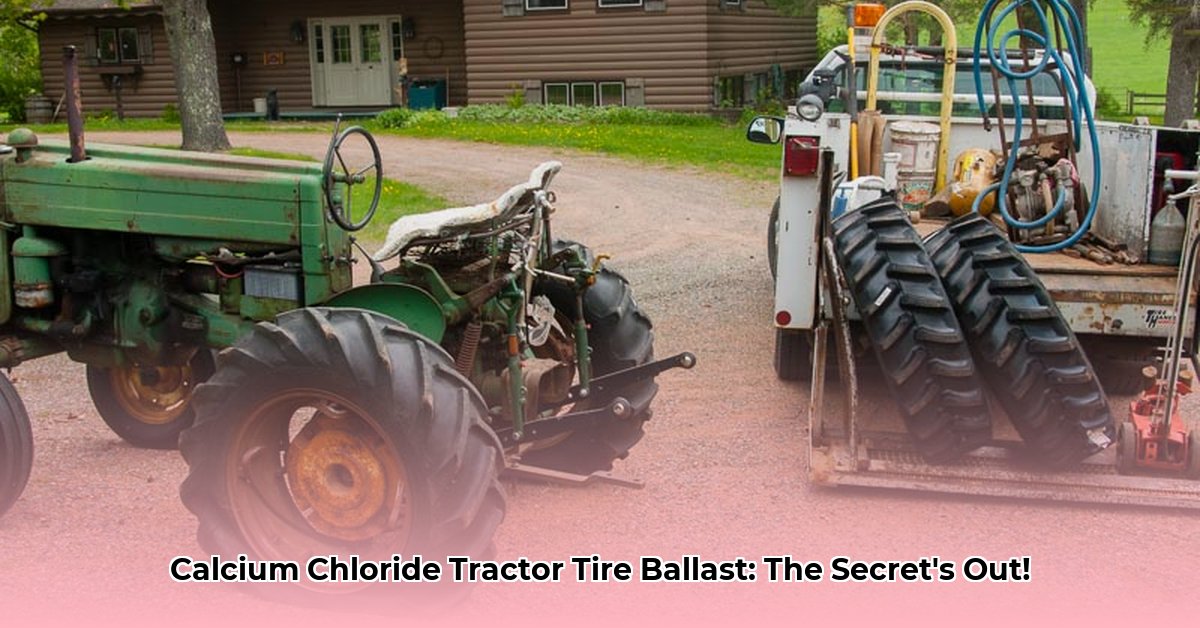
Getting your tractor tires properly weighted is crucial for optimal traction, stability, and a smoother ride. While water is a common and inexpensive ballast, its limitations—primarily its susceptibility to freezing—make it unsuitable for many farming operations. For more on calcium chloride, see this guide. This guide provides a comprehensive comparison of various liquid ballast options, focusing on calcium chloride, and offers a step-by-step approach to selecting and safely using the best solution for your farm.
Understanding Your Ballast Needs
Maintaining adequate tire weight is vital for safe and efficient farming, particularly in challenging terrains or during inclement weather. Water, while readily available and cheap, offers limited weight and freezes easily, significantly reducing its effectiveness in colder climates. This necessitates exploring alternative ballasts that provide superior performance and address environmental concerns. But how do you choose the right one?
Comparing Ballast Options: A Detailed Analysis
We’ll compare calcium chloride to other common ballasts based on key criteria: freeze resistance, weight density, cost, environmental impact, and safety. Remember, the ideal choice depends heavily on your specific farming context.
| Ballast Type | Freeze Resistance (°F) | Weight Density (relative to water) | Cost | Environmental Impact | Safety Considerations |
|---|---|---|---|---|---|
| Water | 32 (freezes) | 1 | Low | Low | Generally safe, but may become a breeding ground for bacteria |
| Antifreeze (Propylene Glycol) | -50 to -60 | 1.04 | Medium | Moderate | Relatively safe, but avoid skin contact and dispose properly |
| Antifreeze (Ethylene Glycol) | -50 to -60 (varies) | 1.11 | Medium | High | Highly toxic, requires specialized handling and disposal |
| Calcium Chloride | -50 to -60 | 1.4 | Low | Moderate | Corrosive; requires protective gear; proper disposal crucial |
| Beet Juice | 28-32 (varies) | ~1 | High | Low | Generally safe, but may spoil and attract insects |
| Windshield Washer Fluid | Varies widely | ~1 | Low | High | May contain harmful chemicals; check composition carefully |
Note: These figures are approximate, and actual performance may vary based on concentration and specific product formulation.
Choosing the Right Ballast: A Step-by-Step Guide
Selecting the optimal ballast involves a multi-faceted decision-making process:
Climate Assessment: Harsh winters demand ballasts with exceptional freeze resistance (calcium chloride or propylene glycol). In milder climates, a wider range of options becomes viable.
Budgetary Constraints: Water represents the most affordable option, but its limitations might lead to higher long-term costs due to frequent refilling. Calcium chloride offers a cost-effective compromise between performance and price.
Environmental Considerations: Beet juice, while more expensive, provides a sustainable alternative, minimizing environmental impact. Consider carefully the disposal methods for all options.
Prioritizing Safety: Ethylene glycol antifreeze's toxicity necessitates careful avoidance. Calcium chloride requires meticulous handling due to its corrosive nature. Always consult the Safety Data Sheet (SDS) before use.
Decision Matrix: Use the following matrix to aid your decision, prioritizing the factors most important to your operation:
| Factor | Water | Propylene Glycol | Ethylene Glycol | Calcium Chloride | Beet Juice | Windshield Washer Fluid |
|---|---|---|---|---|---|---|
| Freeze Resistance | Poor | Excellent | Excellent | Excellent | Fair | Variable |
| Cost | Low | Medium | Medium | Low | High | Low |
| Environmental Impact | Low | Moderate | High | Moderate | Low | High |
| Safety | Good | Good | Dangerous | Moderate | Good | Moderate |
Safe Handling of Calcium Chloride: A Detailed Protocol
Calcium chloride's corrosive nature mandates strict safety procedures:
Protective Gear: Always wear chemical-resistant gloves, eye protection (goggles), and long sleeves.
Tire Preparation: Inspect tires for any damage before adding ballast. Consider inner liners for added protection against corrosion.
Controlled Addition: Use a funnel and hose to slowly add calcium chloride, preventing spills and splashes. Work in a well-ventilated area.
Responsible Disposal: Adhere to local environmental regulations for disposing of used calcium chloride solutions. Never pour it down drains or onto the ground.
Resource Recommendations
For detailed information on safe chemical handling, sustainable agricultural practices, and local environmental regulations, consult resources like your local agricultural extension agency and the Environmental Protection Agency (EPA) website.
Choosing the right tractor tire ballast demands a careful evaluation of your unique needs and priorities. This guide furnishes a solid foundation for informed decision-making, but remember to always conduct thorough research specific to your region and farming practices.